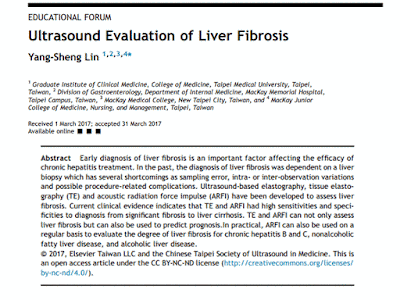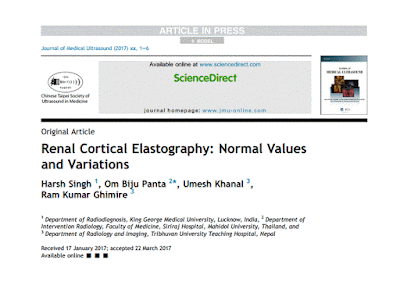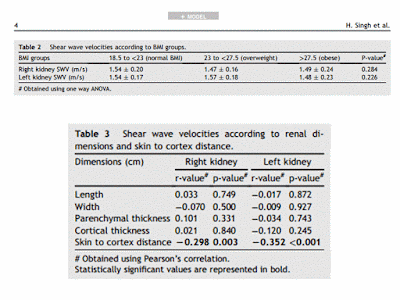Hình siêu âm, Nghệ thuật, và Phỏng
đoán lâm sàng
trong thực hành siêu âm
Tôi đã nhận được một quảng cáo trên mạng
xã hội từ teespring.com. Họ đã đưa ra một văn bản trên áo T-shirt với điều này:
"Bác sĩ: danh từ. [Dok-ter] là người giải quyết vấn đề mà bạn không biết là
bạn đã có trong khi bạn không hiểu. Xem thêm thầy phù thủy wizard,magician
".
Tôi thích điều này. Tìm và khắc phục
một vấn đề chưa biết là tất cả về những
gì của chẩn đoán sớm. Đây là cả một lãnh vực đang diễn ra và đang nổi lên của
siêu âm. Phần 'hiểu biết' đã từng là các trường hợp lâm sàng trong y khoa. Vượt
qua rào cản đó, để đối chiếu kiến thức khoa học với những điều không
chắc chắn rộng lớn trong khi phải hành động, là điều mà các bác sĩ siêu âm phải
làm mỗi ngày. Làm được điều này là một trong những thành tựu to lớn của con người.
Làm thế nào để chúng ta quyết định
sử dụng siêu âm tốt nhất như thế nào, ở đâu, lúc nào khi công cụ của chúng ta
trở nên đáng tin cậy hơn, kiến thức và kinh nghiệm của chúng ta tăng lên và khi có cơ hội mới
để chia sẻ và lồng ghép với các phương tiện chăm sóc sức khoẻ khác? Đây là một vấn
đề cơ bản mà chúng ta quan tâm. Trên thực tế, đây là những vấn đề tương tự đã
đối mặt với các nghệ sĩ kể từ khi người vẽ cổ đại đầu tiên ở Pháp đã quyết định phết màu khoáng mới nhất của mình trên đá trong hang động [Grotte De Lascaux] cách đây 20.000 năm. Theo
một tạp chí kỹ thuật, vách đá khó có thể để giao lưu và thông tin trong thời đá
cũ, nhưng, bạn ơi, cuối cùng họ đã làm.
Tác phẩm của các nghệ sĩ là sự sáng
tạo. Nghệ thuật có thể bị áp lực bởi các lực lượng văn hoá xã hội; để thực hiện
cần có sự quen thuộc với chủ đề, phương tiện, và các công cụ trong tay. Tôi
nghĩ rằng rất nhiều vấn đề mà siêu âm phải
đối mặt đến từ việc không xác định người thực hành như là một nghệ sĩ thị giác
đầu tiên và như là một người sử dụng các
công cụ 'khoa học' thứ hai. Nghệ sĩ "truyền thống" tìm cách tiết lộ đôi điều về chủ đề của mình, đó có thể là một tâm trạng hay một ký ức, và
chọn phương tiện và kỹ thuật để truyền đạt khái niệm đó. Còn các siêu âm nghệ sĩ có
một nhiệm vụ, đó là mô tả được rõ tối
đa bệnh lý.
.....
Một số máy có thể điều khiển 'persistence' [ quán tính thị giác ] trung bình cho một vài khung hình, trong khi loại máy
khác được thiết kế có tính năng này. Khoảng bốn khung hình là tốt nhất cho hầu hết các ứng
dụng. Điều này giống như tăng thời gian phơi sáng cho khẩu độ tương tự mà không làm quá tải
cảm biến. Tỷ số tín hiệu-nhiễu liên quan đến căn bậc hai của số lượng mẫu. Vì vậy, bốn khung
sẽ giúp bạn giảm đi 2 lần tiếng ồn so với trung bình không khung hình, và tốc độ quét sẽ
không bị làm chậm đi. Đôi khi hãy thử điều này với động mạch cảnh ở mặt cắt ngang. Với
mức trung bình độ sáng tăng lên và độ tương phản giảm xuống, mục tiêu khám di chuyển sẽ bị mờ. Nếu bạn khám động mạch cảnh, hãy làm đầy hình ảnh càng nhiều càng tốt. Khảo sát ở cỡ khung hình nhỏ hoặc đối tượng phần mềm khám với ma trận hiển thị
sẽ không bị nhiễu, nhưng hậu quả là các chi tiết nhỏ sẽ không được hiển thị......
Gain [khuếch đại] và công suất đầu ra
Việc điều
khiển siêu âm cơ bản là gain, toàn thể hoặc trong khoang sâu. Đầu dò có độ mở ống kính tương đối thấp. Các
đơn vị tạo chùm đơn giản trước đây tạo ra một hình ảnh tổng hợp từ một đến vài vùng tiêu
điểm riêng biệt. Các đơn vị chùm sóng âm mạnh mới nhất (sóng phẳng và các đơn vị gần như ba chiều) có thể đạt được
các vùng tiêu điểm rộng thông qua quá trình xử lý tín hiệu số. Thay đổi được gain cũng giống như làm tăng ISO trong máy ảnh kỹ thuật số. Gain càng cao, biên độ tín hiệu càng cao, hình ảnh càng sáng và nhiễu ồn càng tràn ngập các đặc trưng không có tín hiệu. Các máy siêu âm ban đầu giống như di chuyển một khe
trước máy ảnh trong khi chớp sáng hàng trăm hoặc hàng ngàn lần mỗi giây. Các máy siêu âm hiện đại hơn có các nguồn âm giống như đèn nhấp nháy [strobe lights=lóe nhanh rồi tắt liên tục], thời khoản ngắn, cường độ cao và có băng thông rất rộng. Các đặc trưng phổ của tín hiệu siêu âm tương đương với
thành phần màu của ánh sáng. Tôi sẽ không đi sâu thêm
phần này vì là yếu tố khác biệt giữa các dòng máy nhưng thích hợp để xác định các
kiểu của cùng hãng chế tạo máy.
Tôi thường vận hành máy với cài đặt đầu ra với năng lượng cao nhất mà máy cho phép.
Có những giới hạn quy định đối với nhà sản xuất, theo tôi, là hoàn toàn tùy tiện. Công suất
tối đa như ánh sáng trời có nghĩa là chất lượng hình ảnh tốt hơn (chủ yếu giảm xuống nhiễu
ồn, mặc dù không đơn giản). Gain (hoạt động trên tín hiệu nhận được) được giảm thiểu
. Ngoài ra, hình ảnh tốt hơn nghĩa là các lần khám nhanh hơn với độ phơi nhiễm thấp hơn,
chiến thuật này là pro-ALARA [As Low As Reasonably Achievable, càng giảm liều xạ xa
liều giới hạn càng tốt]. Để cho công bằng, xác định liều lượng [dosimetry] của siêu âm là
một loại sa lầy với ít điểm mốc. Các xung siêu âm có những dạng sóng kỳ lạ khác
khi biến đổi thành các xung lan truyền. Không rõ chỉ số nào là đại diện cho việc
truyền năng lượng thực tế trong mô, cũng như không thể xác định việc chuyển từ
các đơn vị cường độ thấp trong khi quét cho tốt.
Tương phản
Tôi nghĩ rằng cách điều khiển máy siêu âm quan trọng nhất (và ít được sử dụng và đánh giá cao) là 'Dynamic Range', DynR, hoặc tín hiệu log nén. Có nhớ mức độ phơi sáng? Phạm vi của biên độ echo cho hầu hết các trường mô [tissue fields] lớn hơn các đơn vị hiển thị có thể xử lý; Nén log tín hiệu phễu hóa [funnels] biên độ echo xuống bề rộng hình có thể được hiển thị (và cảm nhận). Các màn hình hiển thị có tỷ lệ tương phản tốt hơn rất nhiều so với 10 năm trước, nhưng đây vẫn là một thiết lập quan trọng và nó kết hợp với bảng tra cứu [look-up table] chi phối màu xám hoặc màu sắc được gán cho các khối biên độ tín hiệu nhỏ. Một số máy đầu tiên trong thập niên 1970 của hình ảnh xám đã gây ra hai lỗi nghiêm trọng. Đầu tiên là để hiển thị hình ảnh màu đen / xám trên nền trắng. Hãy suy nghĩ về nó: bạn có thể nhìn thấy sao trời ban ngày không? Khác với giả định rằng các cơ quan là chất rắn đồng nhất và có quan niệm thẩm mỹ rằng chúng nên có một kết cấu mịn. Để có được kết quả họ vận hành với rất nhiều tín hiệu nén và tự hào rằng các máy lúc ấy có thể hiển thị tín hiệu 70 hoặc 80 dB thay vì chì là 40 hoặc 50. Đó là sai. Dải động hiển thị không khác nhiều nhưng việc nén tín hiệu làm tăng nhiễu ồn và làm cho nó sáng như mô thực sự và làm đầy các lỗ rỗng. Do đó không thể nhận thấy được sự tương phản. Hệ quả cụ thể là hiệu quả chẩn đoán tụt thấp, không thể phát hiện (hoặc loại trừ) các khối u ác tính nguyên phát và thứ phát ở gan, vì chúng không khác gì nền gan. Ý tưởng ban đầu để thiết lập nén tín hiệu rất cao và để mặc nó một mình sau đó là một sự lựa chọn mỹ thuật, nhưng không tốt cho siêu âm. Có một vấn đề tương đương trong nhiếp ảnh, có thể được giải quyết bằng trọng số trung bình của nhiều hình ảnh giống hệt nhau với các yếu tố tiếp xúc khác nhau, được gọi là xử lý 'HDR'. Bây giờ, nhận ra rằng sự tương phản là vấn đề quan trọng nhất để hình dung tổn thương khu trú và sự khác biệt vùng trong thành phần collagen của mô. Điều chỉnh và hiệu chỉnh lại DynR để có thể hiển thị tối ưu những gì bạn muốn chứng minh trong khi đang quét. Hãy chọn các cài đặt đẹp nhất khi bạn bắt đầu quét, trước khi bạn nhìn vào nội dung của hình ảnh.
Cài đặt máy [Presets]
Từ những năm 1990, nhiều nhà sản xuất đã nhận ra có những người dùng không thích điều chỉnh máy cho từng bệnh nhân và từng loại nghiên cứu. Tôi nhớ các máy với các vận hành được ghi âm, để chứng minh là "các cài đặt này đang chạy" (và không bao giờ có thể tìm thấy nữa). Một vài công ty đã cài đặt một lần[one step] dựa trên phân bố biên độ tín hiệu trong hình ảnh dùng làm điểm khởi sự cho một lần khám, rồi để lại tất cả cho các điều khiển hoạt động. Cách tiếp cận thường gặp hơn là có một nút ấn cài đặt sao cho là tốt nhất cho một số chương trình khám, như tuyến giáp hoặc gan, và đôi khi thêm cho các yếu tố như béo phì hoặc tam cá nguyệt của thai kỳ. Những cài đặt trước đó chỉ là kết hợp của các vận hành có sẵn, mà chúng khá là xúc phạm cho người làm siêu âm chuyên nghiệp. Khái niệm này cũng là một sai lầm, bởi vì các bệnh lý thì cố định, còn các cơ quan thì biến đổi. Điều đó làm cho bệnh lý chủ mô, ngay cả được cho là ẩn dụ, cũng bị giới hạn.
Hình ảnh số hóa đã làm thay đổi mọi thứ. Các máy siêu âm có hoặc cần phải có các vận hành cơ bản tối ưu hóa trong một cuộc khám, và có một vận hành bậc hai, như cách mà các màu xám được bản đồ hóa cường độ tín hiệu, mà không cần điều chỉnh nhiều. Và sau đó, có nhiều vận hành khác được làm ẩn hoàn toàn với người dùng. Có phần mềm kiểm soát việc tạo chùm âm, tổng hợp ảnh và xử lý hình ảnh tương tác, trong đó một số cài đặt không ổn định và sẽ gây ra sự cố hệ thống hoặc dẫn đến hình ảnh thiếu trung thực và thay đổi các tùy chọn cần được cơ quan quản lý phê duyệt riêng biệt. Đây là nơi mà các chế độ xử lý khác nhau được người khám chọn như cài đặt trước, tức là trước khi có hình ảnh xảy ra [pre-processing]. Thực sự đáng tiếc là cùng một từ được sử dụng. Các cài đặt sẵn trong các hệ thống được gắn nhãn, như hòa âm, kết hợp max rez, độ sâu tối đa, chứ không phải là các vùng giải phẫu. Đây thực sự là phần chính của máy siêu âm, cũng là umbrella [ multitined array (umbrella) probes] của đầu dò, các tùy chọn hiển thị và tất cả các thành phần của phần cứng khác.
...
Tạo hình siêu âm không phải trò vui đùa, và cũng không phải sở thích riêng. Bạn không thể tách rời hình siêu âm của bệnh nhân khỏi đầu dò, khỏi máy siêu âm có được dữ liệu này và khỏi người xem nhìn thấy hình siêu âm đó, cả sự điều chỉnh chất lượng hình lẫn việc thuyết minh nó. Tất cả những điều này cùng nhau xác định siêu âm là một nghệ thuật.


































